How to choose laptop CPU that meets the needs (part 2)
In the previous part 1, we talked about the indicators related to Core i and CPU generation when deciding which CPU models are suitable for laptops, in the next part, VnReview will learn more about readers CPU lines and why consider this one of the key factors in deciding the CPU for a laptop.
For those who have experience in distinguishing Core i or CPU CPUs, their evaluation and selection of laptop CPUs will be based primarily on the CPU product line.

CPU series and priorities for your laptop use
Overall, choosing the right CPU product line is more important than comparing Core i7 or Core i5 with Core i3. Intel has 4 main CPU lines: Xeon E, HQ / HD, U and Y, each line is divided into many different Core i3, i5 and i7 sets. Besides, the TDP index (power consumption) is also very different, ranging from 4.5W for Y-series and even up to 45W for HQ-Series.
In the explanation of Core i, users also know that higher TDP often means faster processing speed, but is more likely to cause heat and power consumption. However, relying on a low TDP index to evaluate a laptop that has a longer battery life is not entirely true. The LaptopMag page has a detailed review of some 4.5W TDP CPU models and concludes that, the battery life is below average due to its low battery capacity and power-consuming screen.
The consultant below will continue to dive into the CPU lines that best suit the user's needs:
Xeon line E : Only for high-end workstations
- Advantages : For technical, research or professional graphics.
- Disadvantages : Battery life is reduced, costly and expensive.
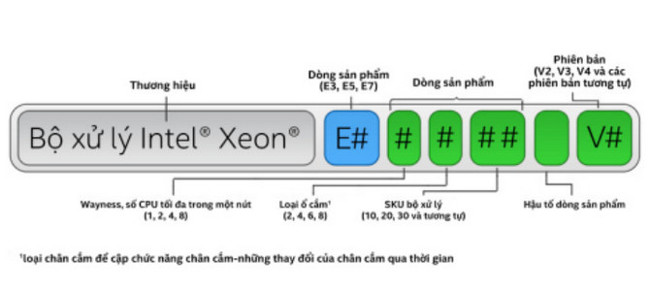
For today's high-end mobile workstations, Intel Xeon E3 is an excellent choice. Intel Xeon E3 CPU offers 4 physical cores, comes with Hyper-Threading technology, Turbo Boost and TDP 45W.
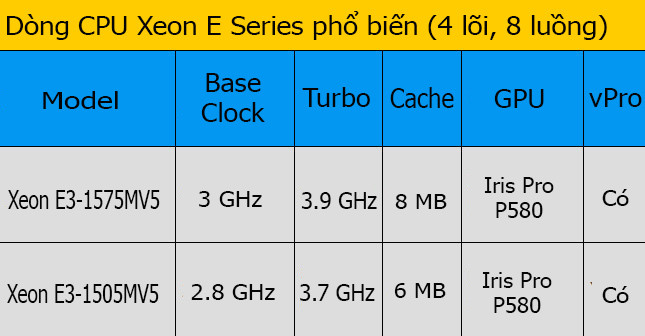
Thanks to such remarkable power, the Intel Xeon E3 CPU allows users of laptop workstations to handle 3D graphics or use complex simulation software in the field of medical or technical research.
Series HQ / HK: For those who require high performance
- Advantages : Suitable for gaming people, creative experts or high-performance users.
- Disadvantages : Ability to move, price and battery life.
If you are a professional gamer or a creative designer, a laptop equipped with CPU or HQ series will definitely become very important.HQ CPU series has four cores instead of only two cores as on the U and Y series. Besides, thanks to hyper-threading technology, an Intel Core i7 CPU can be divided into 8 threads simultaneously for processing capability. outstanding.
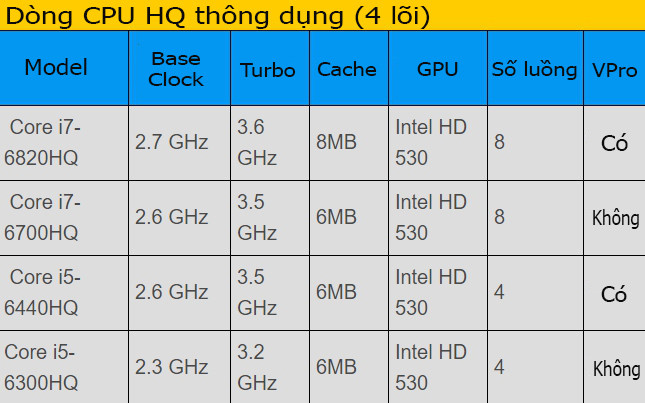
The HQ CPU series has a TDP of 45W , which means that the battery life will be reduced quickly if there is no large battery capacity because most of the CPU CPUs generate greater heat than the U chip. rarely find a laptop running an Intel HQ chip that is super light or ultra-thin.
HK is like the HQ series, but the chip line is capable of unlocking multiplier, serving for overclocking, increasing CPU processing speed in many cases. Currently, both HQ and HK lines stop at the 6th generation (Skylake) and promise to be upgraded to Skylake in early 2017.
U Series: Common performance stream
- Advantages : Suitable for those who want a laptop that satisfies the performance and battery life criteria.
- Disadvantages : Difficult to play games or do graphics that require high performance.
It is a power-saving CPU series but still satisfies quite a lot of processing requirements of common users. The U series has a TDP of 15W , which is a very significant number for those who want a good battery life to handle tasks on the computer.
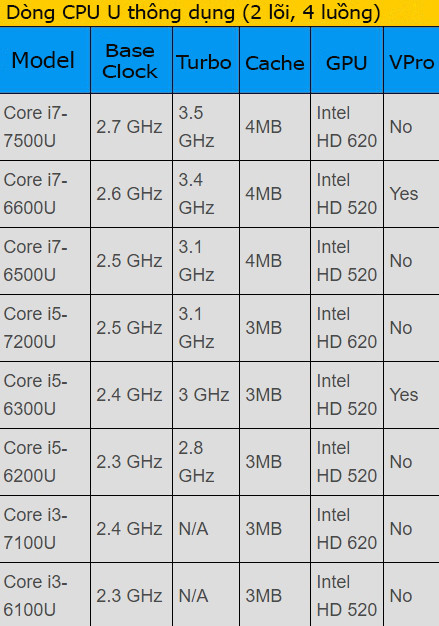
Most laptops running U-series have a large battery capacity and good battery life , up to 10-20 hours depending on the user's needs.
Y-series / Core m series: The series is for fanless, light and thin design, mainly for mobile
- Advantages : Fanless design, moderate performance and optimized design.
- Disadvantages : Battery life and performance are not high.
When shopping for laptops, you will find models using Core m3 / Core i5 / Core i7 Y-series chips (Kaby Lake) or Core m3 / m5 / m7 (Skylake). These are the most energy-efficient chips, the processing performance is at an acceptable level and is most suitable for laptops aimed at ultra-thin designs, without cooling fans.
Intel Y-series chips have a relatively low TDP , only about 4.5W . As a result, the Y-series chips always give the highest power saving capability. However, most laptops that use Y-series chips often come with low battery capacity, poor performance due to lowered clock speeds or high energy-consuming screens.
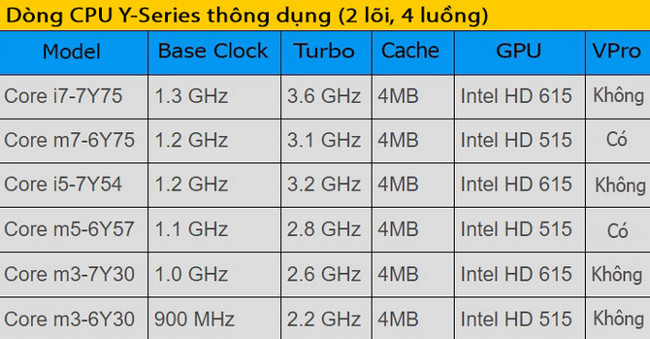
The price of the current Y-series chips is also quite cheap. Since being upgraded to the Kaby Lake generation, the Y-series chips have been commercialized as Core m3 (base version), Core i5 and Core i7. The sixth generation chips (Skylake) are still called Core m3, m5, and m7 respectively. The name Intel Core M often sees the commercial name of the Y-series chip and has the following Y character between the generation indicator and the SKU digit.
Celeron / Pentium: Suitable for basic users
- Advantages : Low cost, enough to meet basic needs such as surfing the web, listening to music, watching movies, .
- Disadvantages : Difficulties in the ability to handle games, video editing, poor performance.
If you are looking for a laptop that sells for between 200-400 USD (about 4.5 - 9 million VND), you will definitely see the appearance of Celeron / Pentium chips. Basically, these are two low-cost CPUs, providing moderate performance, enough to meet tasks such as web surfing, email reading and other lightweight tasks. The Celeron line is currently quite popular on Chromebooks running Google's Chrome OS because it doesn't require too much processing power from hardware like Windows.
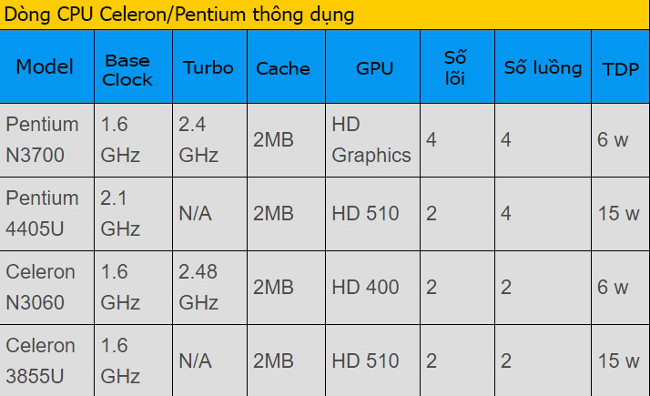
Celeron CPU line has TDP ranging from 4-15W . The first name of the Intel Celeron laptop model is usually N (for example, N3060), which consumes 4-6W of power , while the tail chip ends in U with a 15W TDP with the Better productivity. Battery life can vary greatly depending on battery capacity, but many reviews show that the CPU with 4-6W power consumption will usually be cheaper and have a longer battery life.
Although less common, the Pentium series is more powerful than the Celeron. Pentium CPU has TDP ranging from 6-15W, most of them are 6-7.5W. One of the outstanding laptop models using Intel Pentium can be mentioned as Asus Vivobook E403SA, Intel Pentium N3700 chip machine, battery life can last up to 9 hours and cost only about 400 USD (about 9.1 million VND) ).
Intel Atom: Suitable for users who want an auxiliary device
- Advantages : Low cost, long battery life, light weight
- Disadvantages : Multitasking ability and performance are not high
Intel Atom can be considered the cheapest CPU of Intel. These chips often appear in many super-cheap Windows laptops (hybrid laptops) or Windows tablets such as Lenovo IdeadPad 100S and Asus Transformer Mini T102HA. Most Intel Atom series have 4 cores and are relatively energy-efficient, unfortunately this is the weakest chip.
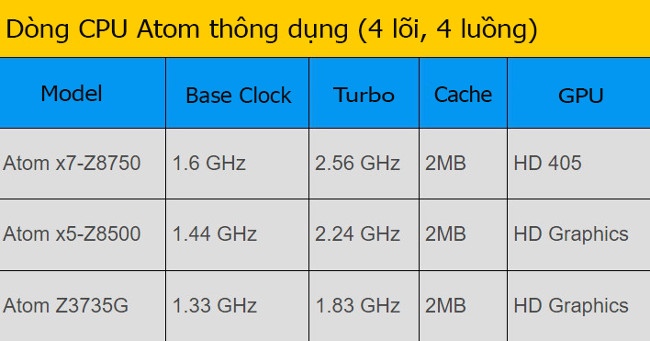
Perhaps so, Intel Atom should only be for those who want an auxiliary device, or just serve very basic needs such as surfing the web, watching videos.
Intel did not publish details of the Intel Atom TDP, but it revealed that the Intel Atom line has a Scenario Design Power (SDP) - one of the indicators used to measure the power consumption of a Y chip. -series reaches about 2-2.5W, which is only about half the amount of power consumed by Y chips which is already the lowest. And it is not surprising to know that the Lenovo 100S model costs only about 200 USD but can operate up to 10 hours continuously.
Integrated graphics chip
All laptop CPUs come with integrated graphics chips (GPUs). On most Core i3 / i5 / i7 CPUs, GPUs are often named Intel HD Graphics and a figure behind them. The current 7th generation CPU starts with number 6 (Intel HD Graphic 620) and the 6th generation is No. 5 (Intel HD Graphic 520). Some CPU lines are even equipped with graphics chip Iris Graphic or Iris Pro Graphics , these are the most advanced graphics chips from Intel with many outstanding features.
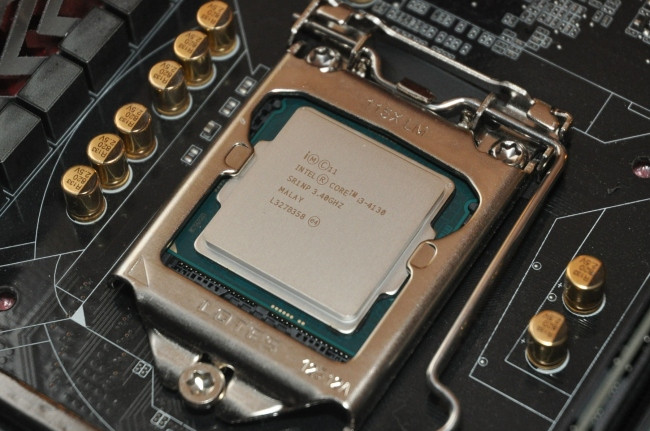
Most integrated GPUs are attached directly to the CPU, so the coordination between different GPU and CPU lines is impossible. For example, Intel Core i7 6500U CPU can only use Intel HD Graphics 520 GPU.
Once again, the issue of user needs is central to the selection of integrated CPU graphics chips. If you had a good choice with the CPU, choosing a GPU would not seem so important if users only use laptops for basic purposes such as office work, low-profile gaming, web surfing, watch video,.
However, if the original purpose is a machine with good graphics editing capabilities and professional gaming capabilities, it is important to choose a laptop with an additional GPU slot. There are currently two vendors offering well-known discrete GPUs such as Nvidia and AMD . In particular, the selling price of GPUs offered by AMD is somewhat cheaper than Nvidia, in return for Nvidia's GPU line, which provides a slightly better graphics performance.
Some structural component issues
In general, the CPU is not the most important factor determining a laptop's performance . The reason is that even the slowest CPUs, if combined with other better hardware such as SSDs or discrete GPUs, will still provide an equally perfect experience.
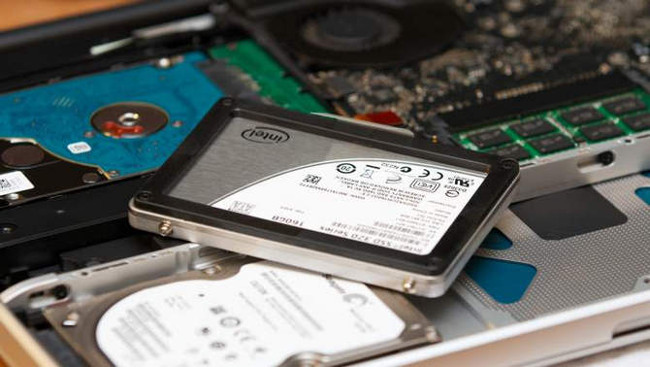
Obviously, instead of trying to upgrade to higher chip or Core i series, users can consider to equip a high-end SSD or discrete GPU suitable for work needs. And sometimes these hardware are the factors that create the power for a laptop that users want.
summary
The article provides the most general knowledge on how to read CPU, CPU and concept parameters that can affect decisions when choosing a laptop CPU of the user. Of course, before and after reading this article, users need to always question their own needs when choosing laptop CPUs, which will have a clearer direction in choosing laptop CPUs to meet individual or public needs. job.
Hopefully, through the above separate analysis, users who are universal or advanced will know how to choose for themselves a laptop model.
Good luck!
You should read it
- Notes when choosing to buy a laptop
- Move a lot, choose which laptop?
- Instructions for choosing laptop configuration
- Do you need a laptop with a 'stone pot'?
- The new Eee PC version will have an Intel Atom chip and a hard drive
- Choose a laptop for the new school year - You know how?
- Do you know how to choose a laptop to buy?
- Choose Core i3 laptop priced from 7 million VND for the new school year
May be interested
- Do you need a laptop with a 'stone pot'?
 just like gaming laptops or high-performance models, the more durable a laptop with a design and exterior, the more expensive it will be.
just like gaming laptops or high-performance models, the more durable a laptop with a design and exterior, the more expensive it will be. - How to choose to buy a GPU for a computer
 graphics cards are an indispensable part for some computer users. these are the criteria that help you choose the gpu that suits your needs.
graphics cards are an indispensable part for some computer users. these are the criteria that help you choose the gpu that suits your needs. - How to choose a laptop with a good screen
 the screen is one of the components attached to the laptop but has not been given adequate attention when choosing and buying the device. you should also consider the following factors to choose the best laptop screen.
the screen is one of the components attached to the laptop but has not been given adequate attention when choosing and buying the device. you should also consider the following factors to choose the best laptop screen. - A few things to keep in mind when choosing to buy a laptop under VND 10 million
 things to note below will help you choose to buy a laptop for less than 10 million but still ensure the basic elements such as beautiful, cheap, durable.
things to note below will help you choose to buy a laptop for less than 10 million but still ensure the basic elements such as beautiful, cheap, durable. - To buy an old laptop like that
 buying an old laptop is always risky, to choose the old laptop you should look for among the best laptops of last year. next is to choose where to buy ...
buying an old laptop is always risky, to choose the old laptop you should look for among the best laptops of last year. next is to choose where to buy ... - Does Desktop or Laptop Really Save You Money Over Time?
 you intend to buy a computer but do not know whether to choose a laptop or a desktop. let's look at the pros and cons of these two types of computers and choose a suitable computer for yourself.
you intend to buy a computer but do not know whether to choose a laptop or a desktop. let's look at the pros and cons of these two types of computers and choose a suitable computer for yourself. - Office people choose tablet or ultrabook?
 many people believe that ultrabook is a laptop, while tablets are like a large smartphone. but after all, they are both 'computers' and you are in the middle of choosing to buy either, not both.
many people believe that ultrabook is a laptop, while tablets are like a large smartphone. but after all, they are both 'computers' and you are in the middle of choosing to buy either, not both. - The mistakes are easy to make when buying a laptop
 even if you've ever owned a few laptops and clearly determined what features you like, or what your actual use is, it's not necessarily possible to help you. ' immune 'with some mistakes ...
even if you've ever owned a few laptops and clearly determined what features you like, or what your actual use is, it's not necessarily possible to help you. ' immune 'with some mistakes ... - Do you know how to choose a laptop to buy?
 choosing a laptop is a big challenge for consumers today. here is what you need to find out before deciding to buy the product.
choosing a laptop is a big challenge for consumers today. here is what you need to find out before deciding to buy the product. - What is a laptop cooling pad? Instructions on how to choose a heat sink
 laptop cooling pads play an extremely important role in radiating heat and cooling the laptop. consult huy khang pc now to choose a heatsink here.
laptop cooling pads play an extremely important role in radiating heat and cooling the laptop. consult huy khang pc now to choose a heatsink here.










 How to automatically update drivers on Windows using SnailDriver
How to automatically update drivers on Windows using SnailDriver Steps to fix charging laptop not to power
Steps to fix charging laptop not to power What is Intel's new Core i9 CPU line?
What is Intel's new Core i9 CPU line? How to update the driver for NVIDIA video card
How to update the driver for NVIDIA video card How to prevent heat for laptops effectively
How to prevent heat for laptops effectively 5 outstanding laptops sold in June 2015
5 outstanding laptops sold in June 2015